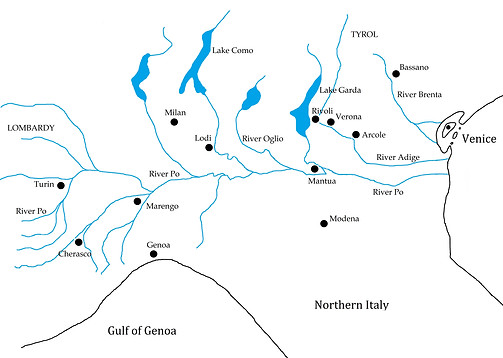
1796-7: Napoleon in Italy
The Battle of Arcole
The remaining attempts at retaking Mantua came under a different general, the Hungarian General Jozeph Alvinczy von Borberek. The third attempt to relieve Mantua was thwarted by Napoleon at the Battle of Arcole - Alvinczy had a far larger army however he made the mistake of dividing his forces, allowing Napoleon to exploit his weaknesses. The Battle of Arcole was a great challenge for Napoleon, whose army was outnumbered two to one. On top of this, the French had been sorely beaten by the Austrians just days earlier on November 12th in the town of Caldiero, which was only two days march from Verona. The French army were exhausted as a result of Caldiero being taken and retaken numerous times throughout the day – nonetheless, at the end of the day the Austrians still held the town. Bonaparte’s plan was to surprise the Austrians as they retreated along the road that ran from Verona to Vicenza and cut into their line from the south with support from Augereau and Massena’s divisions. Bonaparte hoped this would convince Alvinczy to abandon his siege of Verona and turn back – however, taking Bonaparte’s positions into account, he would be forced to march his army through the marshy lands near the village of Villanova. This is where Napoleon would strike his decisive blow; a clever plan as he knew he was outnumbered, thus by forcing his enemy into unfavourable terrain he would have an advantage. Tens of thousands of enemy troops getting stuck in a marshy bog would certainly counteract their numerical advantage.

Map of Italy in the 1800s
(Author's Collection)
On November 15th Augereau and Massena led their men across the Adige river at Ronco, trying desperately to break Austrian defences on the bridge. After several failures, Napoleon ordered a retreat back to Ronco to formulate a better plan. Things started to look better for Napoleon’s army on November 17th when Augereau’s troops were ordered to cross the shallower Alpone river, whilst Massena stayed at Ronco ready to make another attempt to cross the Adige. The cunning manoeuvre of Augereau’s troops worked perfectly and soon both Massena and Augereau’s divisions were driving towards Arcole, pushing Alvinczy to retreat towards Trieste within a few days. Thus, Alvinczy’s first attempt to retake Mantua was thwarted by Napoleon, despite the latter reportedly being thrown from his horse into a marshy bog and had to be rescued by his brother Louis and General Marmont. Nevertheless, Napoleon paraded this victory as one of his greatest achievements even though his success was probably down to stubbornness rather than skill.
Alvinczy’s second attempt to relieve Mantua came a couple of months later in January 1797. After the defeat at Arcole, Alvinczy reorganised and reinforced his divisions at Trent then formulated a plan to divide his 50,000 troops. Alvinczy would take the bulk of force, around 28,000 men, and march directly down the Mincio towards Rivoli with 6,500 men protecting his rear. Bajalich , who had served under Wurmser in the Rhine, would march 6,000 men towards Verona via Bassano and Provera would take 9,000 men towards Legnano. This type of plan was typical of Alvinczy, who had not seemed to realise that if he united all of his troops against Napoleon he would have a great numerical advantage – more than enough to defeat him. Napoleon organised his forces around Mantua focusing on protecting the North and the East. General Joubert was situated north of Rivoli with 10,000 men, Massena was in Verona with another 10,000, Augereau commanded 10,000 between Ronco and Badia and Serurier commanded a further 8,500 troops on the lines at Mantua. Napoleon also had 4,000 men garrisoned south of Lake Garda, under General Rey.
On 10th January Napoleon was in Bologna negotiating a ceasefire between the Papal States and French Republic with the Pope when he received news of enemy activity. The next day he made his way to Roverbella where he was in a far better position to command. By January 12th Napoleon had predicted an enemy attack from the east and therefore ordered Massena and Augereau to reinforce their divisions using troops from General Rey’s garrison. Following this, Joubert reported on January 13th that heavy enemy presence had forced him to retreat to Rivoli and since Alvinczy was also approaching from the North, Napoleon ordered Massena to join Joubert in Rivoli. Napoleon rode to join forces with Augereau. On January 14th Napoleon sent Joubert and his 10,000 to the largest hill north of Rivoli and at dawn the next day he attacked the Austrians using Joubert’s men. Napoleon intended this ploy to weaken enemy forces until reinforcements arrived – Alvinczy fell straight into the trap and divided his forces further to counter the attack by Joubert. By 10am the French were close to victory and Massena had arrived with 6,000 reinforcements. The Austrians scattered and eventually retreated. Meanwhile, Provera made another futile attempt at Mantua but was stopped by Augereau’s troops.
Got a question? Join the discussion in the forum now!